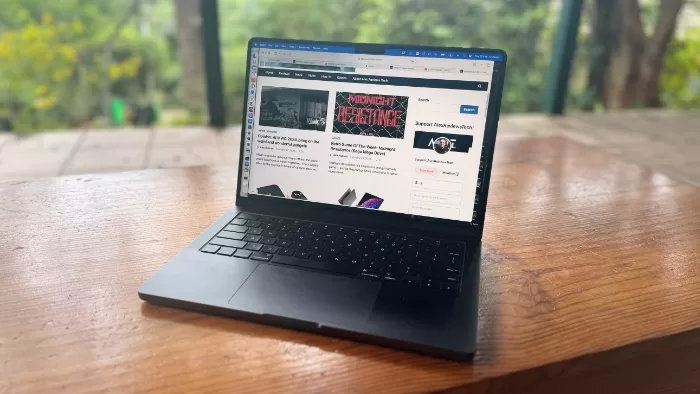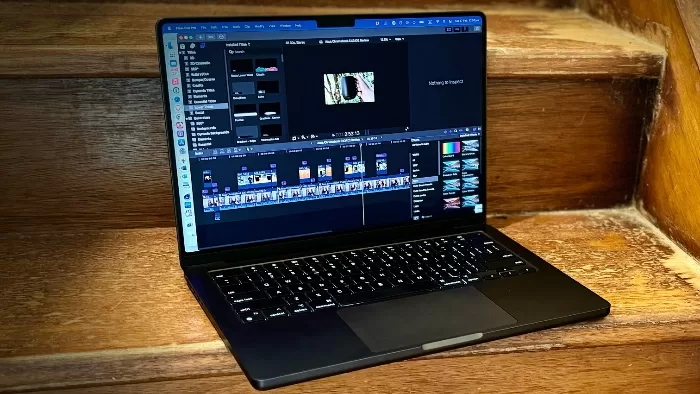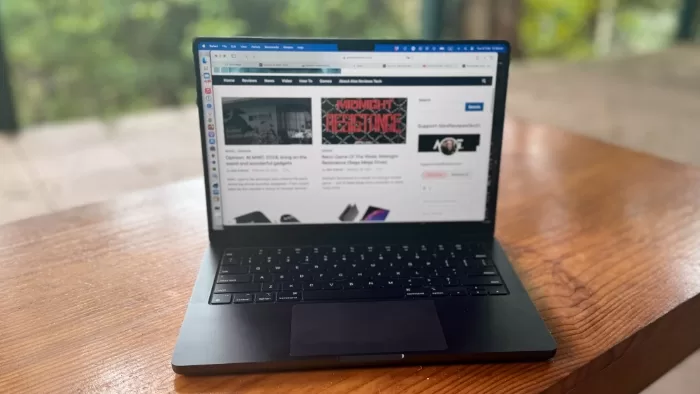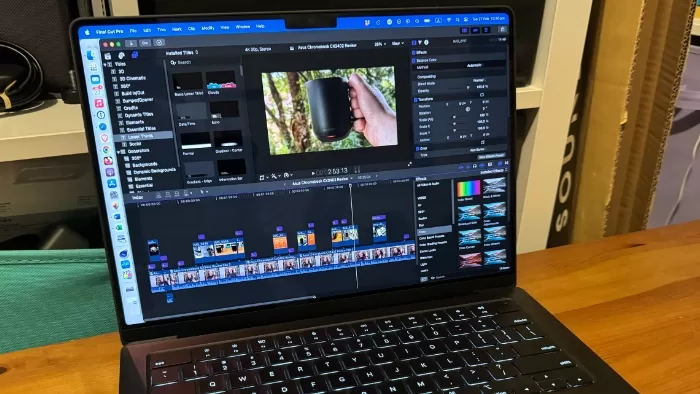
The MacBook Pro M3 Max sits in a class of its own when it comes to power — but buying one will exert a powerful strain on your wallet.
| Pros | Cons |
|---|---|
| Incredibly powerful | Incredibly expensive |
| Lovely display | Only 8GB on the base model is… a choice |
| Decent battery life considering its power | Did I mention frighteningly expensive? Because it’s important. |
Score: 3/5
 |
Buy The Apple MacBook Pro M3! | Buy On Amazon |
It’s been a while since Apple launched the M3 variant of its MacBook Pro line. I’ve been testing out the Apple MacBook Pro M3 Max out over the past few weeks, largely comparing and contrasting it against the day-to-day MacBook Air M2 that’s usually my work machine.
Why compare the Air to the Pro? Largely on price, because Apple’s always charged a premium for its larger Pro-grade laptops – and even the weird 13 inch Pro M1/M2 models it no longer sells.
The MacBook Pro M3 Max is a lovely, fantastically powerful machine, but getting it in a worthwhile configuration will leave a serious dent in your wallet… and then some.
For much of the MacBook Pro’s target market of professional content creators, that’s going to be a price worth bearing because it’ll make enough of an improvement in their day-to-day workflow to pay for itself – or in many cases their employers will be footing the bill.
Design

Apple loaned me the 14 inch model of the Apple MacBook Pro M3, though it also ships a 16 inch variant if you like your laptops on the larger side.
The 14 inch model measures in at 1.55×31.26×22.12cm with a carrying weight of between 1.55 and 1.62kgs. This certainly isn’t an ultralight laptop, and while it’s not tearing my arm off, I can feel the difference in lugging it around compared to the 1.24kg of my 13 inch MacBook Air M2.
The display on the 14 inch model is a 14.2 inch 3024×1964 mini-LED “Liquid Retina XDR” display, designed to work well for the kinds of professionals who have Photoshop code embedded somewhere in their DNA. You either know the type… or you are the type.
It’s a really nice display screen for most working tasks, or for that matter the less-than-serious stuff you might get up to on the weekend, or when the boss isn’t looking. The solid aluminium construction of the Apple MacBook Pro M3 also gives the speakers plenty of chances to shine, with very solid audio output.
The other big difference you’ll see between Apple’s effective entry-level MacBook Air and its MacBook Pro lines is in terms of ports.
The Airs only get USB-4/Thunderbolt ports and headphone/mic sockets, while the Pro models add in SDXC card readers, HDMI and a selection of USB-4/Thunderbolt ports on both sides, depending on the size and processor model chosen.

All the ports!

All the ports! (part two)
Yes, the processor you pick has an effect on the number of ports you get on the sides of your Apple MacBook Pro M3, which is some interesting upselling, right there.
Apple’s Pro-grade laptops have loved their aluminium looks over the years, and the Apple MacBook Pro M3 is no exception.
The new kid on the block here (not that it’s all that new in the Apple world) is “Space Black”. It’s not really that black – certainly not as black as the classic (and very old) Black plastic MacBook of decades prior – but instead a darker aluminium hue.
Apple reckons it’s also fingerprint resistant, though I still found it could get quite smudgy over time. Also it loves to attract cat hair, but that might just be a “me” kind of problem.

Fingerprint resistant? Sure doesn’t look like it.
If you like the look of Space Black, you’re going to have to pay for it – literally. The baseline Apple M3 models of the Apple MacBook Pro M3 come in Space Grey and Silver only, while the Apple M3 Pro and Apple M3 Max have the new Space Black finish – or again Silver if you’re more of a traditionalist.
Performance
When talking about the Apple MacBook Pro M3, I’m really discussing a range of laptops.
That’s because while it’s using Apple’s own M-series silicon, like the prior Pro generations it’s split between the baseline Apple MacBook Pro M3, mid-level MacBook Pro M3 Pro (that’s a lot of Pro), and the top-tier Apple MacBook Pro M3 Max variants. Each tier ups the ante in terms of CPU and GPU cores on board, all built on a more efficient 3nm process.
The model Apple loaned me for review is specifically the Apple MacBook Pro M3 Max with a 16-core CPU, 40 Core GPU, 64GB of RAM and a 2TB SSD embedded in its not-so-tiny silicon brain. That’s quite the recipe for a laptop, and it’s a recipe with components that do cost a premium price.
Specifically in Australia, this configuration runs $7,249. Yes, you read that correctly the first time.
Want to be more scared? It’s far from the most expensive model; if you wanted the 16 inch variant with 128GB RAM and 8TB of storage, you’re on the hook for some $11,699.
To give that the comparative treatment, my ordinary day-to-day MacBook Air M2 (8 Core CPU/10 Core GPU) with 16GB of RAM and GB SSD costs $2,599.
You’re not going to pay that kind of money for ordinary performance – and you certainly don’t get it. While use cases will vary, there’s no doubting that this is a powerful machine that’s capable of a handling very heavy workloads, which it absolutely has to do at this kind of price.
Let’s give that some context, with Geekbench 6’s CPU test. Here’s how a range of Apple machines compare, including the Apple MacBook Pro M3 Max:
That jump up if you were coming from an Intel generation MacBook is quite profound, but there’s a pretty direct improvement curve there in straight up CPU terms.
Video creation is a commonly cited task for these Pro machines, so here’s how Cinebench R23 compares on the Apple MacBook Pro M3 Max:
Again, it’s whomping the field – which, again, it totally should do at this price.
Here the GPU has a role to play, and while I couldn’t gather as much data, because I don’t have those historical benchmarks, I pitted the Macbook Pro M3 Max against the MacBook Air M2 using Geekbench 6’s GPU test. I expected the MacBook Pro M3 Max to win that test… but by how much?
There can be only one response to that.
It’s an impressive result even given the price disparity between the two laptops. I can’t actually daisy chain multiple MacBook Air models together for improved performance, but even if I could, the MacBook Pro M3 Max is delivering 3.2x the GPU performance in that test at just 2.78x the price!
In more anecdotal testing, I’ve been using the Apple MacBook Pro M3 Max as my day to day writing machine (total, but glorious overkill) but also to edit video for my YouTube channel in 4K using Apple’s own Final Cut Pro.
Here, the difference between the Apple MacBook Pro M3 Max and my own machine is quite profound, both in overall rendering time, but also in what else I can do with those systems while working on video.
Put simply, while the Apple MacBook Air M2 can handle video, it’s best suited as a single task machine when doing so, and I need patience for it to flash up the iconic beachball from time to time.
I’m not going to say that I’ve never seen a beachball of waiting pop up on the Apple MacBook Pro M3 Max during my testing, because that wouldn’t be true.
It’s just that the times it has happened, it’s been because I’ve also had other apps open with reference web pages, documents and mail processing as well, something I just can’t do on the Air at all if I want to avoid absolute system lockups.

It's a lean, mean video editing machine.
Now, I can’t speak to the relative differences here between the baseline M3 and M3 Pro, because I don’t have those machines to comparatively test with.
I will note that the absolute baseline Apple MacBook Pro M3 ($2,699, not much more than my Air) only ships with 8GB of RAM, which really feels kind of stingy on Apple’s part. For the Pro crowd, 8GB just isn’t going to cut it.
Being an entirely sealed system, you can’t upgrade RAM after the fact, and the jumps upwards are priced in $300 increments. Basically, budget for a little more RAM than that baseline 8GB at least.
Battery

The Apple MacBook Pro M3 Max is a wonderfully powerful machine, but the use of that power does bring with it challenges in terms of battery life. Charging is – as it’s been for a while now on MacBooks – either via “MagSafe” connected power, or directly via PD-compliant USB-C if you don’t mind sacrificing a USB-C port to do so. That’s my typical style for these laptops, mostly because I use a Thunderbolt dock when working in my office with power passthrough.
Apple’s official figures for the Apple MacBook Pro M3 Max suggest that it should be good for “up to” 12 hours of wireless web work. Here the baseline M3 does a little better with “up to” 15 hours of wireless web time claimed.
As always, that qualifier “up to” needs careful examination, because based on my own experiences, it really does depend on your workloads. If I’m just researching and writing online and I leave the Apple MacBook Pro M3 Max unplugged, that 12 hour figure feels roughly manageable. Certainly a day’s working that way is fine.
However, you’d be certifiable if you spent $7,249 on a laptop just to browse the web. Working with video rendering, those figures drop down considerably.
There’s obviously a balancing act here, and Apple does manage pretty well with power management given what I’m asking the Apple MacBook Pro M3 Max to do. I suspect for most creative professionals the Apple MacBook Pro M3 Max is going to be tethered to a desk much of the time, but if you do work and process heavy data in the field on a consistent basis, you might be hunting a power point before the day is out.
MacBook Pro M3 Max: Alex’s Verdict

It’s hard to get past the sticker shock value of the MacBook Pro M3 Max’s asking price. The unit as reviewed is expensive, and there’s just no getting around that.
However, it’s also very much a tool for a job. Is it probably overkill for much of what I do outside of video production? Undoubtedly, and the personal reality here is that I cannot afford one, as much as I might like one.
However, there absolutely is a market for high-end, high power creative machines like these. The jump over prior generations is marked, especially if you’re coming from an M1 MacBook or older.
The argument case for jumping from an M2 Macbook Pro – and those aren’t actually all that old in laptop terms – is perhaps a little harder to justify unless the performance gains will pay for them quickly. You’ll know already if you’re in the kind of job where that really matters.
MacBook Pro M3 Max: Pricing and availability
The Apple MacBook Pro M3 range in Australia starts pricing at $2,699, but that’s for a straight M3 model.
The unit as tested costs $7,249 at the time of writing. Outside of education discounts and the like, you’re not likely to see these machines in the discount bins any time soon.
Was this review useful to you? Support independent media by dropping a tip via the button below!
 |
Buy The Apple MacBook Pro M3! | Buy On Amazon |
